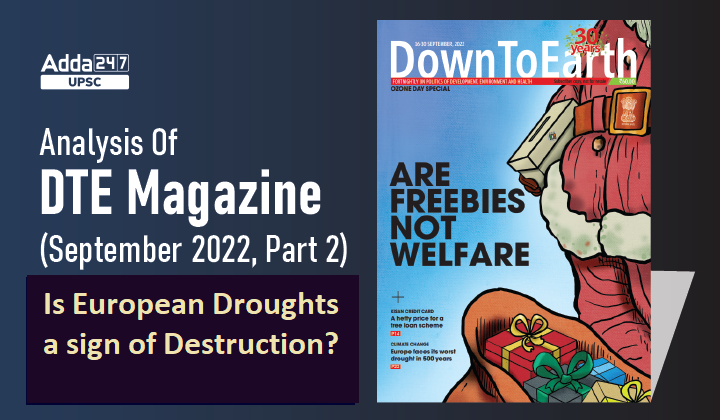Table of Contents
Down To Earth Magazine is a fortnightly magazine focusing on politics of environment and development, published in New Delhi, India.
UPSC Previous years’ questions on Development, Environment, Health and Disaster Management give us a clear idea about the increased importance of Down To Earth Magazine.
Down To Earth Magazine is one of the most important and indispensable sources for UPSC Civil Services Exam Preparation.
Keeping this in mind, here, we come with ”Gist Of Down To Earth Magazine” which covers important environmental current affairs articles in smooth pointed form, keeping in mind the demand of UPSC aspirants.
Is European Droughts a sign of Destruction?: Introduction
- About 4,200 years ago, droughts swept almost every continent—from Asia and Africa to Europe, North America and South America.
- These arid conditions are believed to have persisted for 300 years and caused the collapse of ancient civilisations of Egypt, Mesopotamia, Indus valley and China.
Is European Droughts a sign of Destruction?: Worldwide Scenario
- Worldwide, a similar climatic pattern appears to be taking shape as most continents experience a severe, prolonged drought with rippling effects on everything from food and water to energy availability.
- The Horn of Africa, which is home to the poorest nations of Djibouti, Ethiopia, Somalia and Sudan, faces its worst drought in over 40 years after receiving deficit rainfall for four years in a row.
- The UN says that some 16.2 million people in Ethiopia, Somalia and Kenya are without access to reliable safe water and close to 22 million are at risk of starvation.
- In China, the government issued a nationwide drought alert on August 19 as the country’s heavily populated southern provinces have been experiencing severe heatwaves for months now. Some rivers, including parts of its longest river the Yangtze, have dried up, affecting hydropower, halting shipping and forcing major companies to suspend operations.
- The US is no better, with 43 states experiencing moderate drought or worse in the last week of August, according to the country’s National Integrated Drought Information System. It says 121.5 million people and 90 million hectares are affected by the drought, which has forced several states such as Arizona and Nevada to ration their water withdrawal from rivers for farming.
- The occurrence of drought is particularly worrisome in Europe, which is known to have round-the year moderate rainfall.
Is European Droughts a sign of Destruction?: Why European Droughts are posing serious concerns?
- So far, more than 60 per cent of the European continent and almost all the countries are affected by varying degrees of drought.
- This year’s drought is an extraordinary event and no research has ever expected to see this before 2050.
- Researchers warn that the frequency and spread of severe drought have also been on the rise in Europe in recent years, suggesting that the current drought might become a regular feature for the continent.
- In the past two decades, Europe has recorded six severe droughts in 2003, 2010, 2013, 2015, 2018 and now in 2022. In contrast, the continent saw only three severe droughts —in 1949, 1976 and 1990—in the 20th century(Communications Earth & Environment of Nature).
Why recent droughts have also been unique?
- The recent droughts have also been unique in terms of spread and intensity. For instance, the 2018 droughts impacted the Nordic countries of Denmark, Finland and Sweden, which are known for abundant water resources, short summers and high precipitation.
- In 2015, central and eastern parts of Europe experienced their warmest and driest summers since 1950. The current drought is expected to be the worst in 500 years.
- This is because the entire continent is drier than normal this year.
- In 2018, north and central Europe experienced dry conditions and the south remained wetter than normal.
- This had counterbalanced the negative impacts of droughts.
Is European Droughts a sign of Destruction?: Projections about Future Droughts in Europe
- Future droughts in Europe are more likely to be similar to the current one.
- Projections show that southern Europe is unlikely to get 2018-like rainfall under the high emissions scenario, where global warming by 2100 is projected to increase by 3.3-5.4°C above the pre-industrial level.
- Currently, 64 per cent of Europe is under drought. Future projections show that the event will become more frequent in southern Europe.
What led to the 2022 European droughts?
- The events that led to the 2022 European droughts were set in motion last year.
- According to the European Commission, the 2021 winter season was 2.1o C warmer and annual precipitation was 65 per cent lower than the 1991- 2020 average.
- As a result, the north-western Italian Alps saw an 80 per cent snow deficit last winter, compared to the 2010-2021 period.
Is European Droughts a sign of Destruction?: Rising Heatwaves in Europe
- In the last two decades, the onslaught of combined events of drought and heatwave have occurred in 2003, 2013, 2015, 2018 and again this year. The hotspots of such compound events include parts of western Europe, Italy, the Balkan Peninsula and northern and eastern parts.
- In May to August 2022, Europe experienced a series of heatwaves.
- In the first half of June, a heatwave hit the Iberian Peninsula, spanning Portugal and Spain.
- In July, it extended further north and east, towards France, UK, central Europe and Scandinavia.
- On July 19, the UK for the first time breached the 40o C mark, triggering fires across east London homes. Temperatures also exceeded 40°C in France, 45°C in Spain and 46°C in Portugal
How do Heatwaves occur?
- Heatwaves occur when high-pressure systems form over a region, causing the air to sink.
- The downward movement compresses and warms the air in the lower atmosphere.
- It also traps warm air rising from the ground.
- The effect on near-surface temperature depends on how much energy is used to evaporate water from the ground and plants and how much is heating the air.
- If the soil is already dry or the surface is just concrete and tarmac, then most of the energy will heat the air and increase the magnitude of the heatwave.



 TSPSC Group 1 Question Paper 2024, Downl...
TSPSC Group 1 Question Paper 2024, Downl...
 TSPSC Group 1 Answer key 2024 Out, Downl...
TSPSC Group 1 Answer key 2024 Out, Downl...
 UPSC Prelims 2024 Question Paper, Downlo...
UPSC Prelims 2024 Question Paper, Downlo...





